 | | | Switch to: Europe, USA, New Zealand, Antarctica Credit: NOAA/Ovation  Planetary K-index Planetary K-index
Now: Kp= 0.67 quiet
24-hr max: Kp= 4.00 unsettled
explanation | more data
Interplanetary Mag. Field
Btotal: 12.08 nT
Bz: 3.46 nT north
more data: ACE, DSCOVR
Updated: Today at 1146 UT  Coronal Holes: 17 Apr 25 Coronal Holes: 17 Apr 25 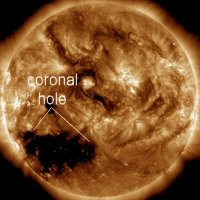
Solar wind flowing from this large southern coronal hole could reach Earth on April 21st. Credit: NASA/SDO | more data  Polar Stratospheric Clouds
Colorful Type II polar stratospheric clouds (PSC) form when the temperature in the stratosphere drops to a staggeringly low -85C. NASA's MERRA-2 climate model predicts when the air up there is cold enough: 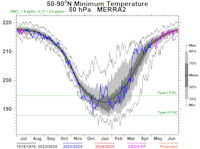
On April 16, 2025, the Arctic stratosphere is much too hot for Type II clouds. | more data. Noctilucent Clouds
The southern season for noctilucent clouds (NLCs) is finished. The first clouds were detected over Antarctica on Nov. 19, 2024, and they vanished again on Feb. 21, 2025. The action will shift to the north pole in late May 2025. Until then, the map will remain blank.
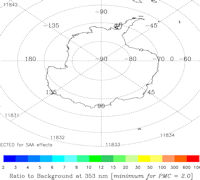
Updated: Feb. 21, 2025
An instrument onboard NOAA 21 (OMPS LP) is able to detect NLCs (also known as "polar mesospheric clouds" or PMCs). In the daily map, above, each dot is a detected cloud. As the season progresses, these dots will multiply in number and shift in hue from blue to red as the brightness of the clouds intensifies.
 SPACE WEATHER
NOAA Forecasts | | Updated at: 2025 Apr 17 2200 UTC FLARE | 0-24 hr | 24-48 hr | CLASS M | 55 % | 55 % | CLASS X | 10 % | 10 % |  Geomagnetic Storms: Geomagnetic Storms:
Probabilities for significant disturbances in Earth's magnetic field are given for three activity levels: active, minor storm, severe storm Updated at: 2025 Apr 17 2200 UTC Mid-latitudes | 0-24 hr | 24-48 hr | ACTIVE | 25 % | 15 % | MINOR | 10 % | 05 % | SEVERE | 01 % | 01 % | High latitudes | 0-24 hr | 24-48 hr | ACTIVE | 15 % | 15 % | MINOR | 25 % | 25 % | SEVERE | 35 % | 25 % | | | |  | | | | | | | | | | | This is an AI Free Zone: Text created by Large Language Models is spreading across the Internet. It's well-written, but frequently inaccurate. If you find a mistake on Spaceweather.com, rest assured it was made by a real human being. | | | THE SEVERE STORM IS SUBSIDING: For much of the past 24 hours, Earth's magnetic field has been reverberating from the impact of a CME on April 15th. It was a Cannibal CME, so it did an extra-good job sparking geomagnetic storms. For a brief time on April 16th, the storm became severe (category G4) with Northern Lights sighted as far south as France. The storm is subsiding now to category G1/G2, which could still produce high-latitude auroras on April 17th. Aurora alerts: SMS Text AURORAS SIGHTED IN BOTH HEMISPHERES: New Zealand astronomer Ian Griffin was trying to sleep when the geomagnetic storm began. "I woke up early, disturbed by the light of the nearly full Moon, and saw the auroras out my bedroom window," says Griffin. "I dressed quickly and hot-footed it to a local beauty spot called Hoopers Inlet on the Otago Peninsula." 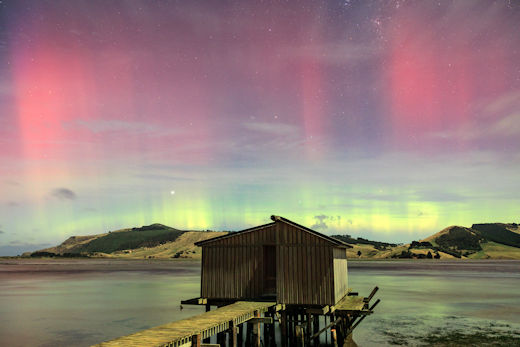
"Despite the bright moonlight, bright auroral rays were visible to the south between 3 am and dawn and my camera captured some lovely red hues," says Griffin. "Now I just have to keep awake for the day job! What a night!" In 2002, NASA did an important aurora experiment. They flew two spacecraft over the poles--one north and one south--to observe auroras simultaneously at opposite ends of the Earth. The results: Northern and Southern Lights appear at the same time and are *almost* mirror images of each other. It comes as no surprise, therefore, that auroras were also dancing half a world away from New Zealand in the northern hemisphere. Marek Nikodem sends this picture from Szubin, Poland: 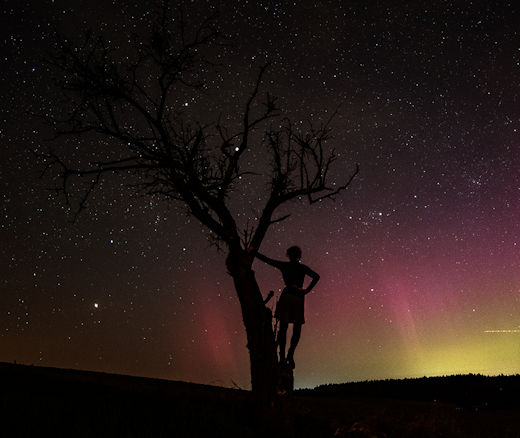
"Here in Poland, the aurora is a relatively rare phenomenon," says Nikodem. "Taking advantage of the good weather, I went out of town with my girlfriend to see the show. An hour before midnight, the aurora was at its most spectacular." Photos of the storm are still arriving. Browse the gallery to see the latest: Realtime Aurora Photo Gallery
Free: Spaceweather.com Newsletter
TOMATO SEEDS FROM SPACE: Spring has arrived, which means it's time to plant your space garden. These tomato seeds have flown to the edge of space onboard an Earth to Sky Calculus cosmic ray research balloon:

You can have a full packet for $49.95. Space seeds make a great DIY science project. During the flight, they spent more than 3 hours floating through the stratosphere, exposed to temperatures as low as -62 C and cosmic ray fluxes 100x Earth-normal. Each space-flown packet comes with an identical control packet, which remained on Earth during the flight. Plant them side by side to discover the difference space travel makes. Far Out Gifts: Earth to Sky Store
All sales support hands-on STEM education
Realtime Space Weather Photo Gallery
Free: Spaceweather.com Newsletter
Realtime Comet Photo Gallery
Free: Spaceweather.com Newsletter Every night, a network of NASA all-sky cameras scans the skies above the United States for meteoritic fireballs. Automated software maintained by NASA's Meteoroid Environment Office calculates their orbits, velocity, penetration depth in Earth's atmosphere and many other characteristics. Daily results are presented here on Spaceweather.com. On Apr 17, 2025, the network reported 8 fireballs.
(8 sporadics) 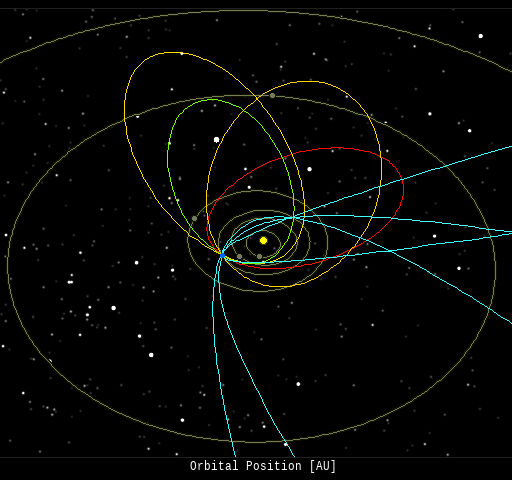 In this diagram of the inner solar system, all of the fireball orbits intersect at a single point--Earth. The orbits are color-coded by velocity, from slow (red) to fast (blue). [Larger image] [movies] Potentially Hazardous Asteroids ( PHAs) are space rocks larger than approximately 100m that can come closer to Earth than 0.05 AU. None of the known PHAs is on a collision course with our planet, although astronomers are finding new ones all the time. On April 17, 2025 there were 2349 potentially hazardous asteroids.
 | Recent & Upcoming Earth-asteroid encounters: | Asteroid | Date(UT) | Miss Distance | Velocity (km/s) | Diameter (m) | | 2015 FS33 | 2025-Apr-12 | 14.6 LD | 20.7 | 107 | | 2025 FP10 | 2025-Apr-12 | 10.8 LD | 14 | 589 | | 2025 GK | 2025-Apr-13 | 17.3 LD | 11.9 | 37 | | 2025 FV13 | 2025-Apr-13 | 18.2 LD | 5 | 29 | | 2023 RX1 | 2025-Apr-13 | 18.1 LD | 1.4 | 3 | | 2025 GP1 | 2025-Apr-14 | 5.7 LD | 5.9 | 23 | | 2023 UH | 2025-Apr-15 | 8.8 LD | 11 | 21 | | 2022 UO | 2025-Apr-15 | 19.8 LD | 16.2 | 18 | | 2025 GQ1 | 2025-Apr-15 | 2.7 LD | 9.8 | 24 | | 2025 DC36 | 2025-Apr-15 | 14.2 LD | 4.9 | 61 | | 2011 VG9 | 2025-Apr-16 | 12.2 LD | 23.8 | 124 | | 2025 GV | 2025-Apr-17 | 15.9 LD | 17.4 | 41 | | 2017 RN16 | 2025-Apr-17 | 10.9 LD | 8.7 | 6 | | 2025 FL20 | 2025-Apr-17 | 13.1 LD | 3.4 | 14 | | 2025 GL1 | 2025-Apr-18 | 17.4 LD | 16.3 | 72 | | 2025 FY22 | 2025-Apr-19 | 9.4 LD | 9.2 | 33 | | 2025 FK12 | 2025-Apr-20 | 9.5 LD | 7.4 | 22 | | 2014 HS124 | 2025-Apr-22 | 10.9 LD | 8.9 | 85 | | 2025 GD1 | 2025-Apr-22 | 4.2 LD | 5.9 | 28 | | 2019 FY2 | 2025-Apr-24 | 12.8 LD | 5.3 | 12 | | 462959 | 2025-Apr-25 | 12.9 LD | 9.5 | 217 | | 2024 BF | 2025-May-01 | 9.5 LD | 4.6 | 46 | | 2024 JM2 | 2025-May-03 | 7.2 LD | 11.3 | 62 | | 2021 JN1 | 2025-May-06 | 18.3 LD | 16.3 | 39 | | 2021 HZ | 2025-May-08 | 20 LD | 10.2 | 30 | | 612356 | 2025-May-09 | 11 LD | 5.1 | 305 | | 2021 KH | 2025-May-10 | 18.3 LD | 7.2 | 19 | | 2011 HJ7 | 2025-May-12 | 6.6 LD | 15.8 | 118 | | 2011 YU74 | 2025-May-13 | 11.4 LD | 5 | 90 | | 2025 DT50 | 2025-May-14 | 16 LD | 6.4 | 105 | | 2008 ST | 2025-May-20 | 13.5 LD | 2.5 | 14 | | 387746 | 2025-May-24 | 17.4 LD | 8.3 | 339 | | 2014 KF22 | 2025-May-25 | 9.1 LD | 11.5 | 19 | | 390725 | 2025-May-25 | 18.4 LD | 13.5 | 410 | | 2025 FU5 | 2025-May-28 | 13.3 LD | 7.3 | 92 | | 2022 KP3 | 2025-May-30 | 10.2 LD | 7.7 | 7 | | 424482 | 2025-Jun-05 | 9.1 LD | 6.2 | 421 | | 2020 LQ | 2025-Jun-06 | 17.3 LD | 11.8 | 34 | | 2018 LE4 | 2025-Jun-07 | 12.2 LD | 13.3 | 62 | | 2014 LL26 | 2025-Jun-08 | 8 LD | 5.2 | 31 | | 2022 KQ5 | 2025-Jun-12 | 13.6 LD | 5.1 | 5 | | 2023 XO15 | 2025-Jun-15 | 17.8 LD | 3.4 | 24 | Notes: LD means "Lunar Distance." 1 LD = 384,401 km, the distance between Earth and the Moon. 1 LD also equals 0.00256 AU. | | Cosmic Rays in the Atmosphere | SPACE WEATHER BALLOON DATA: Almost once a week, Spaceweather.com and the students of Earth to Sky Calculus fly space weather balloons to the stratosphere over California. These balloons are equipped with sensors that detect secondary cosmic rays, a form of radiation from space that can penetrate all the way down to Earth's surface. Our monitoring program has been underway without interruption for 10 years, resulting in a unique dataset of in situ atmospheric measurements. Latest results (Nov. 2024): Atmospheric radiation is decreasing in 2024. Our latest measurements in November registered a 10-year low: 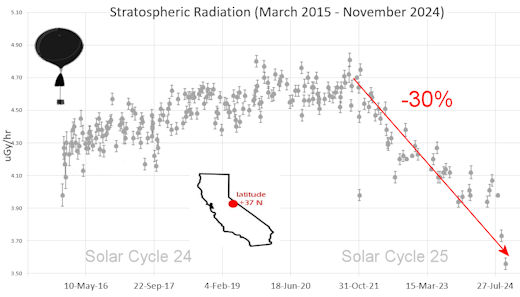
What's going on? Ironically, the radiation drop is caused by increasing solar activity. Solar Cycle 25 has roared to life faster than forecasters expected. The sun's strengthening and increasingly tangled magnetic field repels cosmic rays from deep space. In addition, solar coronal mass ejections (CMEs) sweep aside cosmic rays, causing sharp reductions called "Forbush Decreases." The two effects blend together to bring daily radiation levels down. .Who cares? Cosmic rays are a surprisingly "down to Earth" form of space weather. They can alter the chemistry of the atmosphere, trigger lightning, and penetrate commercial airplanes. According to a study from the Harvard T.H. Chan school of public health, crews of aircraft have higher rates of cancer than the general population. The researchers listed cosmic rays, irregular sleep habits, and chemical contaminants as leading risk factors. A number of controversial studies (#1, #2, #3, #4) go even further, linking cosmic rays with cardiac arrhythmias and sudden cardiac death. Technical notes: The radiation sensors onboard our helium balloons detect X-rays and gamma-rays in the energy range 10 keV to 20 MeV. These energies span the range of medical X-ray machines and airport security scanners. Data points in the graph labeled "Stratospheric Radiation" correspond to the peak of the Regener-Pfotzer maximum, which lies about 67,000 feet above central California. When cosmic rays crash into Earth's atmosphere, they produce a spray of secondary particles that is most intense at the entrance to the stratosphere. Physicists Eric Regener and Georg Pfotzer discovered the maximum using balloons in the 1930s and it is what we are measuring today. | | The official U.S. government space weather bureau | | | The first place to look for information about sundogs, pillars, rainbows and related phenomena. | | | Researchers call it a "Hubble for the sun." SDO is the most advanced solar observatory ever. | | | 3D views of the sun from NASA's Solar and Terrestrial Relations Observatory | | | Realtime and archival images of the Sun from SOHO. | | | information about sunspots based on the latest NOAA/USAF Active Region Summary | | | current counts of failed and deployed Starlink satellites from Jonathan's Space Page. See also, all satellite statistics. | | | Authoritative predictions of space junk and satellite re-entries | | | from the NOAA Space Environment Center | | | fun to read, but should be taken with a grain of salt! Forecasts looking ahead more than a few days are often wrong. | | | from the NOAA Space Environment Center | | | the underlying science of space weather |  | Got a chipped or cracked windshield that prevents you from seeing space weather events while driving? Get windshield replacement from SR Windows & Glass with free mobile auto glass service anywhere in the Phoenix area. |  | BestCSGOGambling is the best site for everything related to CSGO gambling on the web | | | These links help Spaceweather.com stay online. Thank you to our supporters! | | | | | | | | |  | |  |   | ©2021 Spaceweather.com. All rights reserved. This site is penned daily by Dr. Tony Phillips. | |

